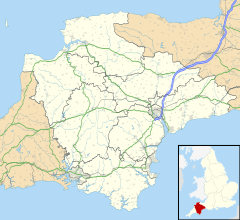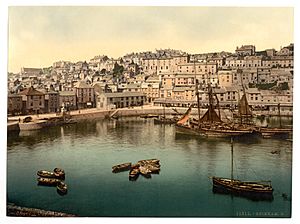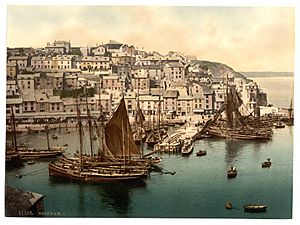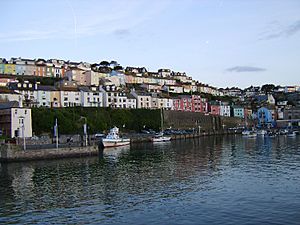Brixham facts for kids
Quick facts for kids Brixham |
|
|---|---|
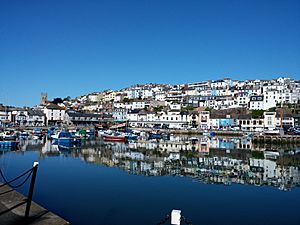 Brixham Harbour |
|
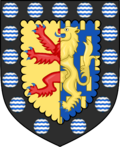 Coat of Arms of Brixham |
|
| Population | 16,825 (2021 Census) |
| OS grid reference | SX9255 |
| Civil parish |
|
| Unitary authority | |
| Ceremonial county | |
| Region | |
| Country | England |
| Sovereign state | United Kingdom |
| Post town | BRIXHAM |
| Postcode district | TQ5 |
| Dialling code | 01803 |
| Police | Devon and Cornwall |
| Fire | Devon and Somerset |
| Ambulance | South Western |
| EU Parliament | South West England |
| UK Parliament |
|
Brixham is a pretty coastal town in Devon, a county in the south-west of England. In 2021, about 16,825 people lived here. Brixham is one of the three main towns in the area, along with Paignton and Torquay.
The name Brixham probably comes from an old resident named Brioc. The word ham means 'home' in Old English. The town is quite hilly and built around a natural harbour. This harbour is home to one of England's biggest fishing fleets. A fun sight to see is a copy of Sir Francis Drake's famous ship, the Golden Hind, which is always docked there.
Long ago, Brixham had two separate parts. Fishtown was near the harbour, and people there were mostly fishermen. About one mile inland was Cowtown, where people worked in farming. These two parts were only connected by a muddy path. Today, St Mary's Square in Cowtown has a large church built on a very old Saxon site.
A very important event happened in Brixham on 5 November 1688. A Dutch prince named William of Orange landed here with many soldiers. He then marched to London to become King William III. This event was a big part of the Glorious Revolution, which changed England's history.
Contents
Brixham's Past
People lived in this area during the Ice age, and there was likely trading in the Bronze Age. But the first real signs of a town come from Saxon times. It's thought that Saxon settlers arrived by sea around the 6th century, or by land around the year 800.
Brixham was called Briseham in the Domesday Book, a very old survey from 1086. Back then, only 39 people lived here. The town grew over time. In 1801, its population was 3,671, and by 1901, it had grown to 8,092.
On 5 November 1688, Prince William of Orange landed in Brixham with his army. He came during the Glorious Revolution to become King of Great Britain and Ireland. He famously declared, "The Liberties of England and The Protestant Religion I Will Maintain." A road leading from the harbour up a steep hill is still called Overgang, which means 'passage' or 'crossing' in Dutch. This is where his army camped.
Brixham has a funny story about the "coffin house." A father once said he would "see his daughter in a coffin before she wed" a certain man. The clever future son-in-law bought a coffin-shaped house and called it the Coffin House. He told the father, "Your wishes will be met, you will see your daughter in a coffin, the Coffin House!" The father was so surprised he gave his blessing.
Many street names in Brixham tell stories about the town's history. Pump Street is where the village pump once stood. Monksbridge was a bridge built by monks from Totnes Priory. Lichfield Drive was the path where the dead were carried to St Mary’s churchyard for burial. Salutation Mews, near the church, reminds us of a time when people would greet the Virgin Mary. Laywell Road is named after Our Lady’s Well. The old white Toll House, seen when entering Brixham from Paignton, was where travelers paid a fee to help keep the roads in good repair.
All Saints' Church, built in 1815, watches over the town. Rev. Francis Lyte, who wrote the famous hymn Abide with Me, was a vicar at this church. He lived in Berry Head House. When he was very ill and close to dying, he looked out from his garden as evening fell over Torbay. The words of his hymn came to him at that moment.
The main church is St. Mary's, located about a mile from the sea. It stands on a very old Celtic burial ground. The first church here was made of wood by the Saxons. It was replaced by a stone Norman church, which was then rebuilt around 1360. Many important people from Brixham are buried in its churchyard.
Many of the pretty cottages above the harbour were once home to fishermen and their families. The famous Coffin House is also near the harbour. Many houses in Higher Brixham were built between the 1930s and 1970s. Some holiday camps were also built here, like Pontin's Wall Park and Dolphin. The Dolphin camp was very large but closed in 1991 after a fire.
Brixham used to have a short railway line from Churston. The line opened in 1868 to carry people and goods, especially fish. It closed in 1963 as part of big railway cuts. Today, the old line to Brixham is overgrown. However, the nearby branch line through Churston is now a heritage railway run by volunteers. It is called the Paignton and Dartmouth Steam Railway.
The British Seaman’s Boys' Home was started in 1863. It helped orphan boys whose fathers were British seamen. It closed in 1988 after 125 years.
Brixham's Sea History
Brixham is famous for improving the fishing trawler in the 1800s. The special red sails of the Brixham trawlers were covered with local red ochre to protect them.
In the Middle Ages, Brixham was the biggest fishing port in the south west of England. It was known as the 'Mother of Deep-Sea Fisheries'. Its boats even helped start fishing industries in places like Hull, Grimsby, and Lowestoft. In the 1890s, Brixham had about 300 trawling boats, mostly owned by individuals. You can still see trawlers entering and leaving the harbour, followed by many seagulls. The fish market sometimes opens to the public in summer. Visitors can learn about catching and cooking fish. Today's boats use diesel, but some old sailing trawlers have been saved.
Many ships have been wrecked on the rocks around Brixham. Fishermen knew the dangers, but a terrible storm on 10 January 1866 surprised everyone. The fishing boats only had sails then and couldn't get back to harbour because of the strong winds and huge waves. The light on the breakwater was also swept away, making it impossible to see. Local stories say that the fishermen's wives brought furniture and bedding to make a huge bonfire on the quay. This helped guide their men home. Fifty vessels were wrecked, and over one hundred lives were lost in that storm. The wreckage stretched for nearly three miles along the coast.
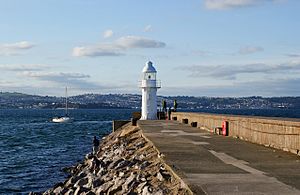
After this sad event, people in Exeter raised money to start the Royal National Lifeboat Institution's Brixham Lifeboat in 1866. Now called Torbay Lifeboat Station, it has modern lifeboats. The crews are very brave and have won 52 awards for their courage. You can visit the boathouse and see memorials to their heroic actions. Sometimes, visitors can even go on board the lifeboat. Two loud bangs are the signal for the lifeboat to launch.
Smuggling was sometimes more profitable than fishing, but if caught, smugglers faced serious punishment. Many local legends tell of gangs avoiding the tax collectors. One funny poem describes a character named Bob Elliott, who had gout and hid in a coffin to escape. Another villain pretended to be the Devil rising from the morning mist to get away. Once, during a cholera outbreak, Brixham smugglers drove their illegal goods from the beach in a hearse. They were followed by people pretending to be mourners, and the horses had muffled hooves to be quiet.
The town's outer harbour is protected by a long breakwater, which is good for sea angling. In winter, you might see purple sandpiper birds here.
South of Brixham, the coastal headland of Berry Head protects the harbour. It has a lighthouse, an Iron Age fort, and is a national nature reserve.
Brixham's Military Role
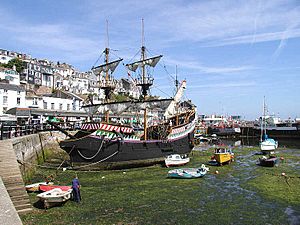
Warships have been seen in Torbay for centuries, from the time of the Vikings until 1944. In 1944, part of the D-Day fleet sailed from here. In 1588, Brixham watched Sir Francis Drake attack the Spanish Armada. Legend says he finished his game of bowls on Plymouth Hoe first! Today, a full-sized copy of Drake's ship, the Golden Hind, is in Brixham harbour. Visitors can go on board.
For hundreds of years, ships sailing down the English Channel would stop in Torbay. They came to find shelter from storms and to get fresh food. These ships included merchant vessels carrying goods and spices, or ships with pilgrims and travelers on the Grand Tour.
Since the time of Henry VIII, Brixham has helped defend the country. Berry Head, now a nature reserve, was once a military site. Guns were placed there to protect naval ships getting supplies in Brixham. Twelve guns were put there during the American Revolutionary War, but removed when peace came. Just ten years later, during a war with France, guns were again placed around the town. Strong forts were built at Berry Head to protect these guns. These forts can still be seen today and are some of the best preserved Napoleonic forts in the country.
During the long wars against France (1689-1815), the Royal Navy came to Brixham for fresh vegetables, beef, and water. Sometimes, twenty or more large men-o'-war ships would be anchored in Torbay. On the harbourside, there is a grey stone building that is now the Her Majesty's Coastguard headquarters. Back then, it was the King's Quay, where the King's ships got their supplies. Local farmers brought vegetables to prevent scurvy, a disease caused by lack of vitamins. Cattle were also butchered, and their meat packed into barrels. Water came from a large reservoir in the middle of town. A pipeline carried it under the streets and harbour to the King's Quay.
Many famous admirals visited Brixham, including Nelson, Lord St. Vincent, and Earl Howe. Earl Howe was even nicknamed Lord Torbay because he spent so much time ashore in Brixham. A very famous visitor was Napoleon Bonaparte, who was a prisoner on HMS Bellerophon. He spent several days off Brixham before being taken to exile on St. Helena.
Battery Gardens also have a military past, going back to the Napoleonic wars and the Spanish Armada. The gun positions you see there today are from the Second World War. They are very important nationally. This site is one of the best preserved of its kind in the UK. During the Second World War, a ramp and piers were built on the breakwater. From here, American servicemen left for the D-Day landings.
Brixham's Industries
Besides fishing, many other local industries were linked to stone. Limestone was dug up and used to build the breakwater, houses, and roads. It was also sent to Dagenham to make steel for Ford cars. Limestone was also burned in special ovens called limekilns. This turned it into a powder used as fertilizer on farms in Devon. You can still see the old quarries and limekilns.
Another mineral found in Brixham is ochre. This gave the old fishing boats their "Red Sails in the Sunset" colour. But the main reason for the red colour was to protect the canvas sails from seawater. The ochre was boiled in large pots with tar, tallow, and oak bark. The oak bark gave its name to the "barking yards." These were places where the hot mixture was painted onto the sails, which were then hung up to dry.
Ochre was also used to make paint. A special paint was invented in Brixham around 1845. It was the first substance in the world that could stop cast iron from rusting. Other types of paint were also made here. The paint works operated until 1961.
Brixham also had iron mines. For a while, they produced high-quality iron ore. However, the last mine closed in 1925. Most of these old mine sites have now been built over, so there are no remains of this important industry.
Brixham's Weather
| Climate data for Brixham, 1981–2010 normals | |||||||||||||
|---|---|---|---|---|---|---|---|---|---|---|---|---|---|
| Month | Jan | Feb | Mar | Apr | May | Jun | Jul | Aug | Sep | Oct | Nov | Dec | Year |
| Mean daily maximum °C (°F) | 9 (48) |
9 (48) |
11 (52) |
13 (55) |
16 (61) |
19 (66) |
21 (70) |
21 (70) |
18 (64) |
15 (59) |
12 (54) |
10 (50) |
15 (58) |
| Mean daily minimum °C (°F) | 4 (39) |
4 (39) |
5 (41) |
6 (43) |
8 (46) |
11 (52) |
13 (55) |
13 (55) |
11 (52) |
9 (48) |
6 (43) |
5 (41) |
8 (46) |
| Average precipitation mm (inches) | 117.0 (4.61) |
89.8 (3.54) |
87.0 (3.43) |
66.2 (2.61) |
67.6 (2.66) |
58.3 (2.30) |
57.4 (2.26) |
64.4 (2.54) |
71.9 (2.83) |
114.1 (4.49) |
112.7 (4.44) |
132.0 (5.20) |
1,038.4 (40.91) |
| Source: Chelsa Climate | |||||||||||||
Fun Festivals and Events
Brixham hosts many exciting festivals and events throughout the year. Local people organize these events, and they bring a lot of visitors and money to the town.
Brixham Pirate Festival
The annual Brixham Pirate Festival usually happens during the early May Bank Holiday. It's famous for its attempts to set world records, live music, and free entertainment. The town fills up with pirates! This festival is a huge event, with thousands of locals and visitors attending every year.
BrixFest
BrixFest is a yearly family-friendly festival in Brixham. It usually takes place in May.
Fishstock Brixham
Fishstock Brixham is a one-day festival celebrating seafood and live music. It raises money for the Fishermen's Mission, which helps fishing families. Volunteers organize this event inside the new Fish Market Development by the harbour. It's usually held on the second Saturday of September, but the date can change depending on the tides.
How Brixham is Governed
| Brixham Town Council | |
|---|---|
 |
|
| Type | |
| Type | |
| History | |
| Founded | 1 April 2007 |
| Leadership | |
|
Mayor
|
Michael Roseveare, Independent
|
|
Deputy Mayor
|
Paul Addison, Independent
|
| Structure | |
| Seats | 12 |
| Salary | None |
| Elections | |
|
Last election
|
4 May 2023 (uncontested) |
| Meeting place | |
 |
|
| Brixham Town Hall, New Road, Brixham, TQ5 8TA | |
| Website | |
| https://www.brixhamtowncouncil.gov.uk/ | |
Brixham has two levels of local government. The first is the Brixham Town Council, which looks after local town matters. The second is Torbay Council, which is a larger authority based in Torquay. Brixham Town Council works from the Brixham Town Hall on New Road.
Brixham used to be an "ancient parish." In the 1860s, it had two main parts: Lower Brixham (by the harbour) and Higher Brixham (on higher ground near the church). Lower Brixham became a local government district in 1862. Before that, the whole area was managed by its church meeting, called a "vestry."
In 1894, local boards became "urban district councils." The Lower Brixham Urban District grew to cover the whole parish of Brixham. In 1895, it changed its name to just Brixham.
In 1968, Brixham and other nearby areas joined to form a larger area called Torbay. Torbay became a "county borough," meaning it was independent from Devon County Council. In 1974, local government changed again, and Torbay became part of Devon County Council once more. But in 1998, Torbay became a "unitary authority," meaning it was independent again. Torbay is still part of the ceremonial county of Devon.
From 1968 to 2007, Torbay Council managed Brixham directly. But on 1 April 2007, a new Brixham Town Council was created. This council declared Brixham a town. In 2011, Brixham Town Hall was given to Brixham Town Council to use as its main office.
Brixham is part of the UK Parliament area called South Devon. Its Member of Parliament (MP) has been Caroline Voaden since 2024.
Schools in Brixham
Brixham has several schools, mostly located in residential areas.
The town has one secondary school, Brixham College.
Other schools and academies in Brixham include:
- Eden Park Primary School Academy
- Brixham Church of England Primary School
- Saint Margaret Clitherow Catholic Primary School
- Furzeham Primary School
Media and News
You can watch local TV news from BBC South West and ITV West Country. These signals come from the Beacon Hill transmitting station and a local relay.
Local radio stations include BBC Radio Devon (104.3 FM), Heart West (96.4 FM), Greatest Hits Radio South West (105.5 FM), Radio Exe (107.3 FM), and Riviera FM (107.9 FM), which is a community station for the town.
The local newspaper for Brixham is the Torquay Herald Express, which comes out on Thursdays.
Sports in Brixham
Brixham is home to the Brixham Archers, the biggest archery club in the area. They practice outdoors at Churston and also have an indoor facility. The club started in 1969 and has won awards at county and national competitions.
Brixham Rugby Club was founded in 1874. It was one of the first members of the Devon RFU. The club plays its home games at Astley Park.
Footballer Dan Gosling, who plays for Watford F.C., grew up in Brixham. He was one of the youngest players ever to play for Plymouth Argyle F.C..
Brixham also has its own football club, Brixham AFC. It was formed in 2012 when Brixham United and Brixham Villa football clubs joined together. The club plays its home matches at Wall Park Ground.
Getting Around Brixham
Brixham railway station was the end of the Torbay and Brixham Railway. It served the town until the line closed in 1963. Some of the old track bed is still there. Houses in Harbour View Close were built where the station used to be.
Even though Brixham no longer has a train station, frequent buses connect it to the national rail network at Paignton. The bus station in Paignton is right across from the train station. Trains from Paignton go to places like Exeter Central, Exmouth, London Paddington, and Birmingham New Street.
Stagecoach South West service 12 is a very popular bus route. It runs every 10 minutes and starts at Brixham Town Square. It goes to Newton Abbot, stopping at Paignton, Torquay, and Kingskerswell. This bus also stops at the Brixham Park and Ride, where you can park your car and ride the bus into town for a flat fee.
Stagecoach service 18 takes about 15 minutes from Brixham (Bank Street) to Kingswear. From Kingswear, you can take a ferry across the river to Dartmouth.
Local bus services, run by Stagecoach and Country Bus, serve areas like Furzeham, Wall Park, Sharkham, South Bay, Higher Brixham, Summercombe, and Hillhead.
You can also take National Express coaches directly from Brixham to London, stopping at Bristol and Heathrow Airport. There are also coaches to Sheffield via Bristol and Birmingham.
Frequent ferry services for people operate from Brixham Harbour to Torquay between April and September. The fastest trip takes 35 minutes. There are also seasonal ferries to Paignton. Fun boat trips also stop at Brixham Harbour on their way from Torquay to Dartmouth during spring, summer, and autumn.
Caves and Monuments
- Windmill Hill Cavern, also known as Brixham Cavern and Philp's Cave
- Ash Hole Cavern
Monuments
- Prince of Orange statue
Famous People from Brixham
- Honoré Willsie Morrow (1880–1940), an American author and magazine editor, was also president of the Brixham Literary and Debating Society.
Images for kids
See also
 In Spanish: Brixham para niños
In Spanish: Brixham para niños


